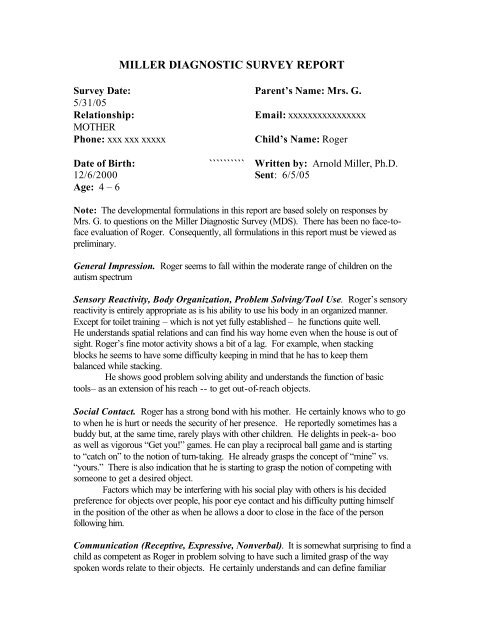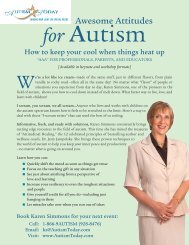Roger's MDS Report - Autism Today
Roger's MDS Report - Autism Today
Roger's MDS Report - Autism Today
You also want an ePaper? Increase the reach of your titles
YUMPU automatically turns print PDFs into web optimized ePapers that Google loves.
MILLER DIAGNOSTIC SURVEY REPORT<br />
Survey Date: Parent’s Name: Mrs. G.<br />
5/31/05<br />
Relationship:<br />
Email: xxxxxxxxxxxxxxxx<br />
MOTHER<br />
Phone: xxx xxx xxxxx<br />
Child’s Name: Roger<br />
Date of Birth:<br />
`````````` Written by: Arnold Miller, Ph.D.<br />
12/6/2000 Sent: 6/5/05<br />
Age: 4 – 6<br />
Note: The developmental formulations in this report are based solely on responses by<br />
Mrs. G. to questions on the Miller Diagnostic Survey (<strong>MDS</strong>). There has been no face-toface<br />
evaluation of Roger. Consequently, all formulations in this report must be viewed as<br />
preliminary.<br />
General Impression. Roger seems to fall within the moderate range of children on the<br />
autism spectrum<br />
Sensory Reactivity, Body Organization, Problem Solving/Tool Use. Roger’s sensory<br />
reactivity is entirely appropriate as is his ability to use his body in an organized manner.<br />
Except for toilet training – which is not yet fully established – he functions quite well.<br />
He understands spatial relations and can find his way home even when the house is out of<br />
sight. Roger’s fine motor activity shows a bit of a lag. For example, when stacking<br />
blocks he seems to have some difficulty keeping in mind that he has to keep them<br />
balanced while stacking.<br />
He shows good problem solving ability and understands the function of basic<br />
tools– as an extension of his reach -- to get out-of-reach objects.<br />
Social Contact. Roger has a strong bond with his mother. He certainly knows who to go<br />
to when he is hurt or needs the security of her presence. He reportedly sometimes has a<br />
buddy but, at the same time, rarely plays with other children. He delights in peek-a- boo<br />
as well as vigorous “Get you!” games. He can play a reciprocal ball game and is starting<br />
to “catch on” to the notion of turn-taking. He already grasps the concept of “mine” vs.<br />
“yours.” There is also indication that he is starting to grasp the notion of competing with<br />
someone to get a desired object.<br />
Factors which may be interfering with his social play with others is his decided<br />
preference for objects over people, his poor eye contact and his difficulty putting himself<br />
in the position of the other as when he allows a door to close in the face of the person<br />
following him.<br />
Communication (Receptive, Expressive, Nonverbal). It is somewhat surprising to find a<br />
child as competent as Roger in problem solving to have such a limited grasp of the way<br />
spoken words relate to their objects. He certainly understands and can define familiar
2<br />
body parts (nose, mouth, etc.) on himself, on another and on a picture. And he will give<br />
an object in front of him to a person requesting it. However, there is a drop in his<br />
capacity as soon as he is asked to give an object that is a few feet from him. This same<br />
drop in capacity is evident when he is asked to bring a specific object from another room.<br />
It becomes even more pronounced when that object is in an unfamiliar place…or when<br />
asked to get two objects. This suggests that Roger has not yet internalized spoken words<br />
and their meanings in a way that lets him “carry” the meaning outside their usual context.<br />
Children who are on the cusp of achieving this will often repetitively mutter the word as<br />
they look for the object it represents in another setting. The muttering or “self talk”<br />
allows them to keep in mind what they are looking for. This suggests that part of Roger’s<br />
problem with communication is learning how to detach words and their meanings from<br />
their usual settings and carry them internally so they may be used everywhere.<br />
This same dependence on words in their familiar contexts accounts, also, for<br />
Roger’s difficulty expressing himself through words. He can sometimes initiate single<br />
words and can always complete a sentence when most of it is given to him. However,<br />
Roger rarely initiates a sentence on his own. Even when he does, he never varies the<br />
sentence structure. Roger’s dependence on an immediate, familiar context in front of<br />
him, accounts also for his inability to use words to refer to events that happened<br />
elsewhere, had happened or will happen.<br />
Examining Roger’s communication further, I find that his communication is<br />
hampered by his echoing what is said to him, by his use of “air words” that have nothing<br />
to do with the other person and by his reversals of I and you.<br />
However, the good news is that Roger’s nonverbal communication is quite good<br />
and can be drawn on to help him maintain meaning outside of familiar contexts. He can<br />
signal his intentions with gesture, can pull a person by the hand to a desired object, can<br />
sometimes point at a desired object and share his pointing with another to make certain<br />
the other knows what he is pointing at. This suggests that incorporating manual sign<br />
language into his program can help him improve his receptive and expressive language<br />
by grounding spoken word meaning with the help of gestures.. The Sign and Spoken<br />
Language Program to be referenced later can be of help in this regard.<br />
Symbolic Functioning. Except for scribbling and make believe play (which he is able to<br />
vary) Roger shows little inclination to get involved with symbolic activities. He rarely<br />
matches pictures to objects and seems not to understand that pointing to a picture can get<br />
him the object represented in that picture.<br />
System Functioning.<br />
Given Roger’s preoccupation with objects and his difficulty with transitions, it is<br />
clear that his autism is of the closed system type. Our experience with such children is<br />
that they often make rapid progress in all sectors if there is a knowledgeable therapist<br />
available to help the child expand and complicate systems and learn how to make<br />
transitions from one place to another.<br />
SUMMARY It seems that the further Roger gets from active physical involvement with<br />
objects and events, the more difficulty he has. Clearly, one of his major issues is how to<br />
cope with a world that is largely unseen but that can be represented in a variety of ways.<br />
2
3<br />
Roger has many strengths but clearly needs help making transition from things to the<br />
symbols which represemt things. This shows itself in his communication and in his<br />
difficulties with pictures and words…Promising, however, is his ability to represent<br />
reality – and to vary it – in his make believe play.<br />
RECOMMENDATION. I recommend that Roger be introduced to manual sign<br />
language. This means that each verbal direction would be paired with a manual sign<br />
related to the object or event. Our experience with the Sign and Spoken Language<br />
Program which pairs spoken with sign language is that it triggers a rapid increase in the<br />
ability to process spoken language. It also results in the child communicating more<br />
effectively with both signs and spoken words. For Roger, sign language should be<br />
viewed as a temporary expedient, to strengthen his understanding and use of words.<br />
Ultimately, he should be able to use spoken language without sign support. You can<br />
view a description of this program on www.cognitivedesigns. com.<br />
With appropriate intervention, Roger’s prognosis for significant gains is very good.<br />
Mother’s response after receiving this report:<br />
The report is a 10, it is so close to being Roger, if<br />
I didn't know better I would've thought you met him in<br />
person!<br />
3





